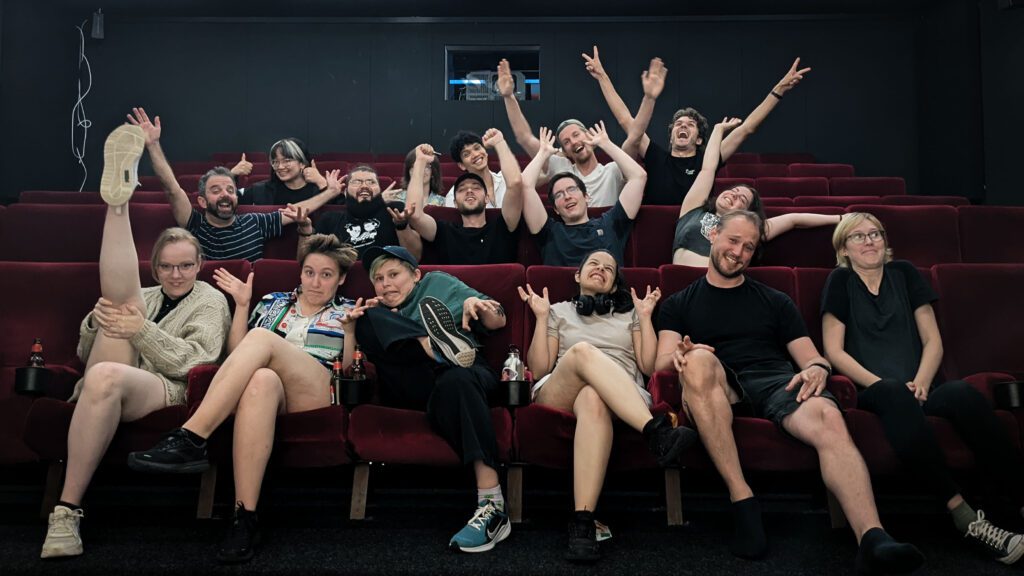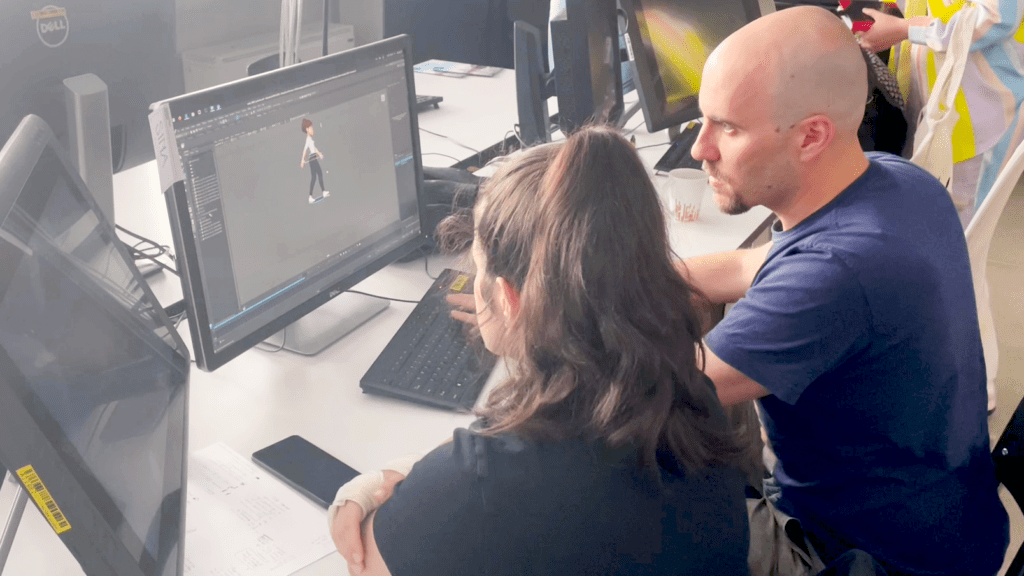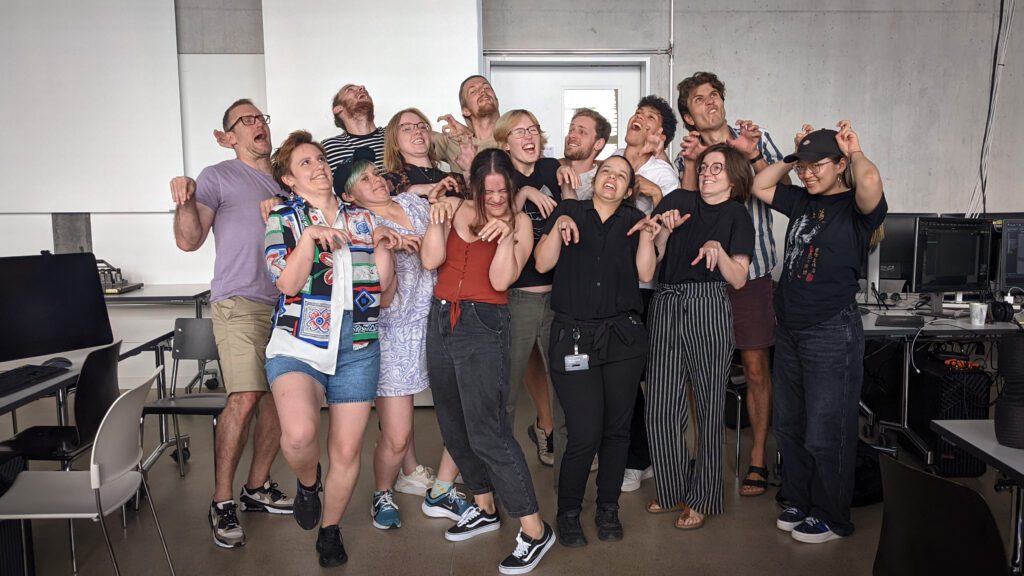LuMAA 2023
1. September 2023
LuMAA 2023
1. September 2023

Another year, another LuMAA!
This time around with air-conditioning. The course and its structure stayed the same, but on hot days, the air-conditioning was a blessing – since PC-stuffed rooms aren’t known for their inherent coolness, temperature-wise. As per usual, we opened the doors of the course to fellow students from partner schools, namely Jirio and Harry from Filmakademie Baden Württemberg, Violette and Robin from MOPA, and Astrid, Sofie, and Liva from TAW. Oh, and us, of course, a rambunctious bunch from HSLU, with first years in the majority.
The location, the PC room of our dear animation department. The students, a wild bunch from all over, eager to learn. The software, Maya, a difficult beast to master. The teachers, a great many with years of experience under their belt, ready to guide us to new heights of animation. So here’s how that went down.
Week 1 – Walk cycles with Yves Ruprecht
Beginnings are difficult. Especially if you have never touched Maya before. Luckily, Yves was there to help us newcomers start off on the right foot, so to speak. He recommended a return to the basics–so we all hopped on a treadmill and shot references of each other. Later, we analyzed our walks as preparation for animating our walk cycles. This task was a familiar one—but this time around, we were able to push them further with Yves’ feedback, be it a vanilla walk or one with more personality.
Yves is not only a kind and motivating person, but also a great informant on everything regarding the animation industry and what to expect as we enter the field. One especially important piece of advice: you need patience to find the right job in this industry. But in the end, that patience pays off.

Week 2 – Lip-sync with Ramon Arango and Noah Demirci
In week two, Ramon and Noah returned to LuMAA–not as students, but as the teachers up front. They told us they were nervous–but seeing how passionately they spoke about the subtleties of facial animation, we would never have known if they hadn’t said so. Two pieces of advice stood out in particular. Firstly, blinks can be wonderfully diverse, and very effective in showing the inner world of a character. Secondly, not every sound has to have its own mouth movement in order to feel believable—a hint is often enough.
“No matter how many years of experience you have in this industry, each new shot is a new challenge … and to realize that was eye-opening. “ – Noah Demirci
Week 3 – Creature Anim: Walk cycles with Lukas Niklaus
Due to a scheduling mistake, Ramon was kind enough to teach for the first two days of the week before Lukas took over. Armed with experience working on creature animation at Weta, the studio behind the VFX of Avatar and LOTR, he was the perfect teacher to help us tackle the quadruped’s walk cycle. Most of us animated a tiger, so he was able to concentrate on teaching us in-depth detail and knowledge about how this marvelous creature moves. Thanks to him, we all managed to incorporate even the smallest details, down to the subtle rotation of the core and the squish of the paws. Alongside teaching, he showed us examples of the impressive professional projects he has taken part in–including work from the studio “floating rocks”, which he is co-leading.

Week 4 – Creature Anim: Body mechanics with Michael Aerni
We all know it to be true–everything in animation is a bouncing ball. Armed with this golden nugget of knowledge and guidance from Michael, we made simple shapes move around. Since Michael animates mainly in a layered fashion, we took it upon ourselves to try it out, with great success. Many liked this layered approach so much, they continued to use it in the following weeks. For the uninitiated, layered animation is a method where you focus first on the movement of the character’s core, and then “layer in” the limbs and other secondary elements. Instead of making one full pose after the other, you slowly build the animation from the core. This has the advantage of making the weight of the character look and feel more believable in less time than a pose-to-pose approach. It is a process that takes a bit to get used to, but is certainly worth learning.
Week 5 – Acting shot with Nicole Ridgewell
The week with Nicole started even before the week began, as we were tasked with finding good dialogue–a quest much more difficult than initially presumed. All recognizable samples (those which are already overused in acting shots) were immediately struck out, and we were sent on a search for our own characters and their stories. That involved daily observational drawing, looking both into ourselves and at the people around us. Adding all of that together, we pitched our shot and got started. Our goal? To reach IP by the end of the week. IP (short for “in progress”) is the stage of production where, although many things are still rough and need to be polished, the central idea of the shot is already clearly communicated and can be built upon with more work. By Friday, we were fully invested in the characters we had built up over the course of the week, and were looking forward to Week 6—when we would finally flesh out the animation in more detail.

Week 6 – Acting shot with Dan Nguyen
Not only did Dan bring his vast understanding of character acting, but also a calmness that perfectly complemented Nicole’s energy from the week before. With his wise words and insightful feedback, we started to polish our acting shot. It takes a lot of time and a good eye to spot which small subtleties require correction, but with Dan’s help, we made great strides in this vital skill. With that we were learning the last lesson of LuMAA, true patience. It takes a lot of time to go from the initial idea to polish. Every curve is cleaned out, all arcs are accounted for, the small deformations of hands are added, cheeks are squished into appealing shapes … all the small details are refined truly bring the performance to life.
“If you don’t have that connection to people who are actually doing the job, it can seem kind of abstract and distant.” – Dan Nguyen
Ping pong and other worthwhile activities
Unbelievably, we did not just animate for six weeks straight, but also lived our lives to the fullest. With such an amazing cast of characters, how could we not have fun? (Besides when we were screaming at our computers.) We cooked together, had weekly barbeque parties, and screened each other’s graduation movies as well as inspiring films and series in the REX (the school’s mini movie theater). Some of us got so good at ping pong that they graduated to playing with dustpans instead of paddles. We learned drinking games and had chocolate and beer tastings.

The weather was wild, from very cold rainy weather, where the aircon was our doom (we could not set the temperature, so it got rather chilly at times), to scorching heat, where the only escape was the river. We went swimming often, floating along with the current, and even enjoying a boat ride.
With all these experiences behind us, Maya almost trauma-bonding us together, and just being around each other for six weeks, it was hard to say goodbye. But time marched onward, and the experience ended. For some, school would commence again soon, while others had to start searching for a job, and yet others were beginning internships. Before we all went our separate ways, we promised we would see each other again soon, be it at festivals, in the industry, or—perhaps—even at next year’s LuMAA.
Thanks to Nicole, Dan, Michael, Lukas, Roman, Noah, and Yves, we now understand that a fulfilling life working in film is not only possible, but likely. Great opportunities await us in the entertainment sector, and we are lucky to be a part of it in these exciting times! One thing all our teachers agreed on: they are happy with their decision to enter the film industry. Even after 20 intense years of working on big movies to independent productions, they couldn’t imagine doing something different. We cannot imagine anything else either.
